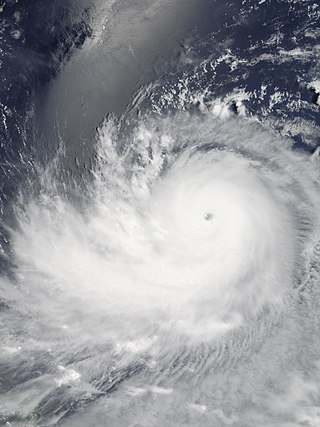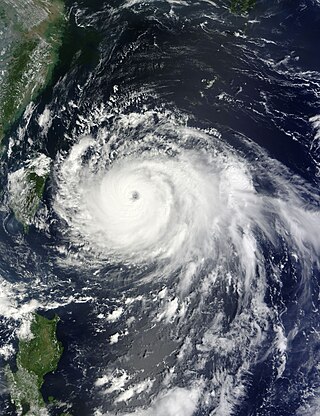
A cloudburst is an extreme amount of precipitation in a short period of time, sometimes accompanied by hail and thunder, which is capable of creating flood conditions. Cloudbursts can quickly dump large amounts of water, e.g. 25 mm of the precipitation corresponds to 25,000 metric tons per square kilometre. However, cloudbursts are infrequent as they occur only via orographic lift or occasionally when a warm air parcel mixes with cooler air, resulting in sudden condensation. At times, a large amount of runoff from higher elevations is mistakenly conflated with a cloudburst. The term "cloudburst" arose from the notion that clouds were akin to water balloons and could burst, resulting in rapid precipitation. Though this idea has since been disproven, the term remains in use.

Fengtai District is a district of the municipality of Beijing. It lies mostly to the southwest of the city center, extending into the city's southwestern suburbs beyond the Sixth Ring Road, but also to the south and, to a smaller extent, the southeast, where it has borders with Chaoyang District and Dongcheng District.

Fangshan District is situated in the southwest of Beijing, 38 km (24 mi) away from downtown Beijing. It has an area of 2,019 square kilometres (780 sq mi) and a population of 814,367. The district is divided into 8 subdistricts, 14 towns, and 6 townships.

Typhoon Longwang, known in the Philippines as Typhoon Maring, was the deadliest tropical cyclone to impact China during the 2005 Pacific typhoon season. Longwang was first identified as a tropical depression on September 25 north of the Mariana Islands. Moving along a general westward track, the system quickly intensified and reached typhoon status on September 27. After reaching Category 4-equivalent intensity on the Saffir–Simpson hurricane scale, adverse atmospheric conditions along with internal structural changes resulted in temporary weakening. The structural change culminated in Longwang becoming an annular typhoon and prompted re-intensification. The storm attained peak strength with winds of 175 km/h (109 mph) and a pressure of 930 mbar on October 1 as it approached Taiwan. Interaction with the mountainous terrain of the island and further structural changes caused some weakening before the typhoon made landfall near Hualien City early on October 2. Crossing the island in six hours, Longwang emerged over the Taiwan Strait before moving onshore again later that day, this time in Fujian Province, China as a minimal typhoon. Once over mainland China, the storm quickly weakened and ultimately dissipated late on October 3.

Typhoon Imbudo, known in the Philippines as Typhoon Harurot, was a powerful typhoon that struck the Philippines and southern China in July 2003. The seventh named storm and fourth typhoon of the season, Imbudo formed on July 15 to the east of the Philippines. The storm moved generally west-northward for much of its duration due to a ridge to the north. Favorable conditions allowed Imbudo to intensify, gradually at first before undergoing rapid deepening on July 19. After reaching typhoon status, Imbudo strengthened further to peak 10–minute sustained winds of 165 km/h (103 mph) on July 20. The typhoon made landfall on northern Luzon near peak intensity on July 22, but quickly weakened over land. Once in the South China Sea, Imbudo re-intensified slightly before making its final landfall in southern China near Yangjiang on July 24, dissipating the next day.

Severe Tropical Storm Kammuri, known in the Philippines as Tropical Storm Lagalag, killed hundreds of people in the wake of a deadly flood season in China. The system developed from a large monsoonal system that persisted toward the end of July 2002 near the Philippines. On August 2, a tropical depression formed off the northwest coast of Luzon and moved west-northwestward. Late on August 3, it intensified into Tropical Storm Kammuri off the coast of Hong Kong. A weakening ridge turned the storm northward toward the coast of China. The storm made landfall with late on August 4, after reaching peak winds of 100 km/h (65 mph). The system dissipated over the mountainous coastline of eastern China and merged with a cold front on August 7.

Typhoon Ewiniar, known in the Philippines as Typhoon Ester, was the third named storm of the 2006 Pacific typhoon season and one that lasted for twelve days as a tropical cyclone, moving on a generally northward track. During its lifespan, it affected Palau, Yap, eastern China, the Ryūkyū Islands of Japan, South Korea as well as North Korea, briefly threatening to make landfall in North Korea before doing so in South Korea. Ewiniar is responsible for at least 181 deaths. However, an unofficial report stated that up to 10,000 people had been killed by flooding in North Korea, with 4,000 people missing.

Typhoon Matsa, known in the Philippines as Typhoon Gorio, was the second of eight Pacific tropical cyclones to make landfall on China during the 2005 Pacific typhoon season. The ninth tropical storm and fifth typhoon of the season, Matsa developed on July 30 to the east of the Philippines. Matsa intensified as it tracked northwestward, and attained peak 10-minute sustained winds of 150 km/h (93 mph) near Taiwan before weakening and striking the Chinese province of Zhejiang on August 5. The system continued northward into the Yellow Sea, and on August 7 Matsa became extratropical after again moving ashore along the Liaodong Peninsula. Matsa is a Laotian name for a lady fish.

Typhoon Wipha, known in the Philippines as Typhoon Goring, was the strongest typhoon to threaten the Chinese coastline since Typhoon Saomai in August 2006. Forming out of a tropical disturbance on September 15, 2007, it quickly developed into a tropical storm, and intensified into a typhoon the following day with the appearance of an eye feature. After a period of rapid intensification, Wipha attained its peak intensity on September 18, with winds of 185 km/h (115 mph) and a barometric pressure of 925 mbar (hPa), according to the Japan Meteorological Agency. Later that day, the storm began to weaken as it interacted with the mountainous terrain of Taiwan before brushing the northern edge of the island. Wipha subsequently made landfall near Fuding along the Fujian–Zhejiang provincial border with winds estimated at 185 km/h (115 mph) by the JTWC. Shortly thereafter, the typhoon weakened as it moved inland, weakening to a tropical storm within 18 hours of moving over land.

The global weather activity of 2010 includes major meteorological events in the Earth's atmosphere during the year, including winter storms, hailstorms, out of season monsoon rain storms, extratropical cyclones, gales, microbursts, flooding, rainstorms, tropical cyclones, and other severe weather events.

The 2010 China floods began in early May 2010. Three hundred and ninety-two people died, and a further 232 people were reported missing as of June 30, 2010, including 57 people in a landslide in Guizhou. Fifty-three of the deaths occurred from the flooding and landslides between May 31 and June 3, and 266 deaths occurred between June 13 and June 29. Four hundred and twenty four people were killed by the end of June, including 42 from the Guizhou landslide; 277 more were killed and 147 were missing in the first two weeks of July, bringing the death toll as of August 5 to 1,072. A landslide in early August in Gansu killed at least 1,471 people and left 294 missing. In total, the flooding and landslides killed at least 3,185 people in China by August 31. More than 230 million people in 28 provinces, municipalities, and regions, especially the southern and central provinces and regions of Zhejiang, Fujian, Jiangxi, Hubei, Hunan, Guangdong, Guangxi, Chongqing Municipality, Gansu, Sichuan, and Guizhou, and the northeastern province of Jilin were affected, while at least 4.66 million people were evacuated because of the risk of flooding and landslides in the latter half of June. By early August, over 12 million people were evacuated, and that number rose to 15.2 million by August 31.

Typhoon Fanapi, known in the Philippines as Typhoon Inday, was a damaging and deadly typhoon that struck Taiwan and southeastern China in September 2010. It was the eleventh tropical storm and fourth typhoon of the very inactive season. The storm formed on September 14 east of the Philippines and moved slowly for several days, initially to the northwest, then curving to the northeast before turning westward due to a ridge to the north. During this time, Fanapi intensified to reach 10 minute maximum sustained winds of 175 km/h (109 mph). Fanapi made its first landfall on September 19 over Hualien, Taiwan, becoming the first typhoon to hit the island since Typhoon Morakot in August 2009. Later that day made a final landfall in Fujian, China. The storm dissipated on September 21 over southern China.
The 2011 China floods were a series of floods from June to September 2011 that occurred in central and southern parts of the People's Republic of China. They were caused by heavy rain that inundated portions of 12 provinces, leaving other provinces still suffering a prolonged drought, and with direct economic losses of nearly US$6.5 billion.

Typhoon Fred was a powerful tropical cyclone that caused extensive damage in southeastern China in mid-August 1994. Regarded as the worst typhoon to affect Zhejiang in 160 years, it originated as an area of disturbed weather over the open West Pacific on August 13. The system moved west-southwest and developed into a tropical depression on August 14. Early on August 15, it intensified into a tropical storm. Fred intensified at a steady rate over the course of several days while moving toward the west. The storm intensified into a typhoon on August 16 and into a super typhoon three days later. Late on August 19, the Japan Meteorological Agency (JMA), the principal organization in the West Pacific, estimated 10-minute sustained winds of 185 km/h (115 mph). The Joint Typhoon Warning Center (JTWC), meanwhile, assessed 1-minute sustained winds of 240 km/h (150 mph). After peaking in intensity, Fred veered to the north of Taiwan and struck the China mainland near Wenzhou early on August 21. The system degraded once inland and dissipated near Wuhan on August 22.

In July 2013, much of southwest China experienced heavy rainfall that led to widespread flooding. Sichuan was the hardest hit. At least 73 people were killed as a result of the flooding, with 180 people missing. An estimated 6 million lives were disrupted by the floods.
In mid-June 2016, severe weather such as heavy rainfall, thunderstorms and hail began across southern China, triggering deadly floods. Over the following month, additional rain events exacerbated flooding and affected more of the country. Areas along the Yangtze River and Huai River have been particularly hard-hit. An estimated 32 million people across 26 provinces were affected and more than 200 people were killed. 280,000 hectares of cropland was destroyed, with state damage estimates of around US$5.73 billion. According to Aon Benfield, the damage estimate has reached US$22 billion. Flooding of this magnitude was last seen in the country in 1998. The floods destroyed over 23,600 houses and left 3,600 refugees homeless.

Heavy rain occurred in Beijing-Tianjin-Hebei region of China—caused by remnants of Typhoon Doksuri—a powerful and destructive tropical cyclone. The remnant dropped up to 744.8 mm of rainfall in Wangjiayuan Reservoir in Changping District with Doksuri setting maximum rainfall records since recordkeeping began during the Qing dynasty in 1883. Overall, the remnants was responsible for 21 deaths and 27 injured.
The 2012 China floods were a series of floods late spring of 2012 and continued during the summer. They have caused high human and economic losses.
















